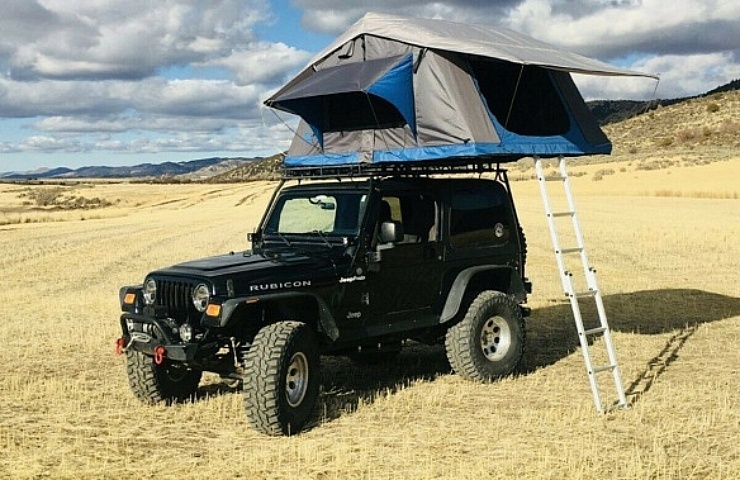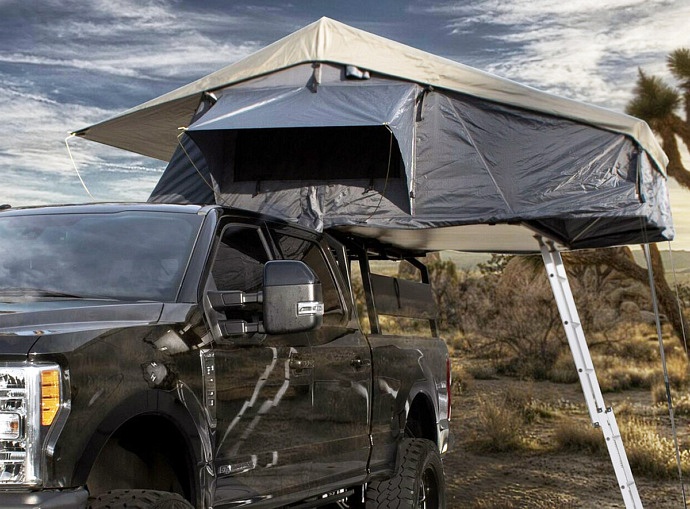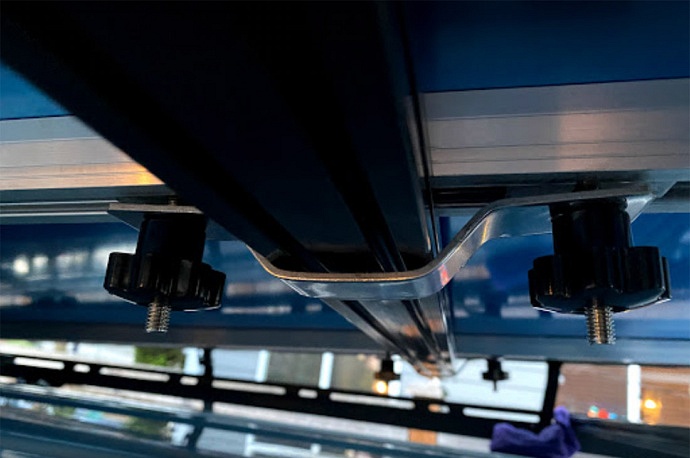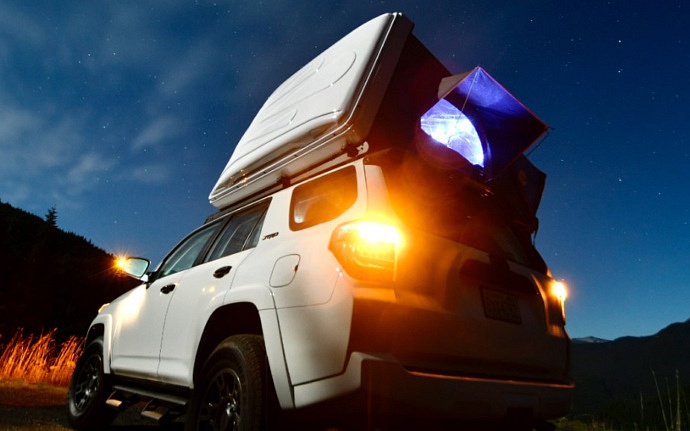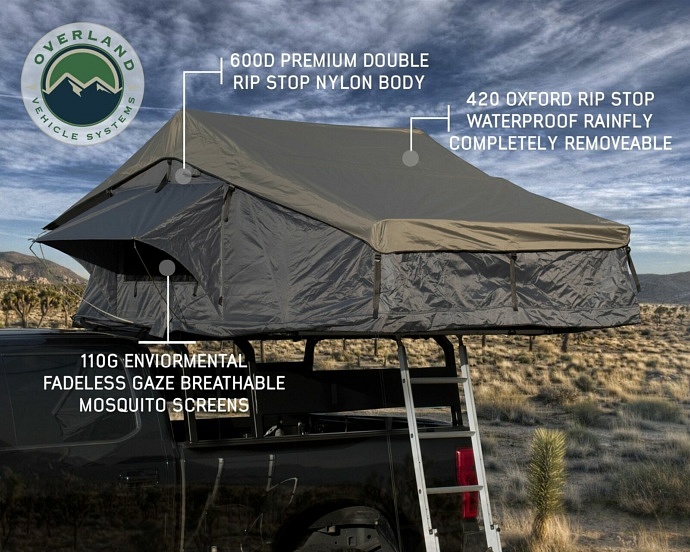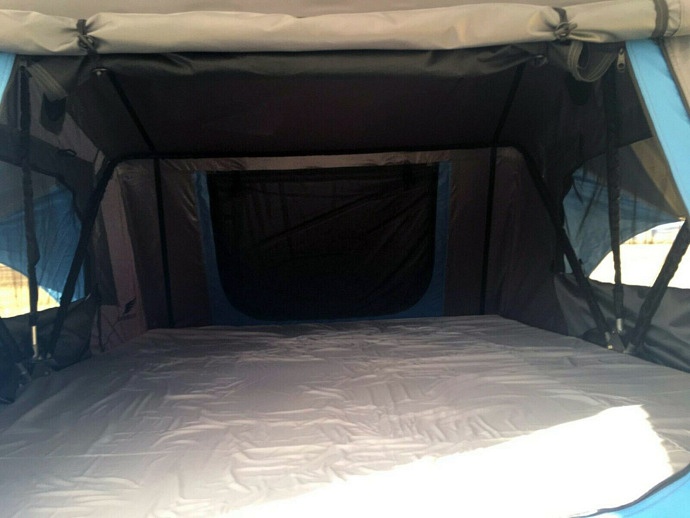Contents
A rooftop tent gives off-road adventurers more choices for remote exploration. There’s no need to clear an area, put down tarps, and build a tent from scratch. Almost any spot that your vehicle can reach can turn into an overnight stay.
Why Use a Rooftop Tent?
Rooftop tents offer people a comfortable night’s sleep on top of their vehicle. In many situations, sleeping on the roof is far more restful than a night spent on frozen or wet terrain.
On top of that, using a rooftop tent is fun. It gives you the feeling of being in a treehouse. And you can use them with many useful and fun accessories. The list of rooftop tent accessories includes:
- Portable LED lighting
- Pouches for organizing shoes or toiletries
- Mesh “cages” to hold other stuff
What Kind of Vehicle Can Be Used with a Rooftop Tent?
You can fit a rooftop tent to a wide range of vehicles—from SUVs and trucks to Jeeps and wagons.
Does your vehicle have factory side rails and crossbars or a platform rack system? Then you are set to install a rooftop tent.
And even if your adventure rig currently does not have side rails, you can often add a complete aftermarket roof-rack system. After you complete that upgrade, you are ready to use a rooftop tent.
Also, you can use all kinds of vehicle roof racks—including platforms, crossbars, or baskets— to mount a new rooftop tent.
How Does a Vehicle’s Roof Weight Limit Work With a Vehicle Top Tent?
Before buying a rooftop tent, make sure that your vehicle or aftermarket rack system can hold the necessary weight for the tent, your gear, and the occupants. It’s up to you to research these weight limits before piling in people and gear.
The maximum capacity of a roof-rack system is mostly determined by the load rating of the roof itself. You can find this info in your vehicle’s owner manual. But every vehicle has two rooftop weight limits: dynamic and static ratings.
- Dynamic capacity is the moving load. It determines how much the roof can hold when the car is driving down the road.
- When parked, people and gear add a lot of weight to a rooftop tent. Most rooftop tent and rack manuals provide details on static weight allowances.
Thule, a tent provider, offers this guidance:
Your vehicle and roof must have a minimum driving (dynamic) weight capacity of of 165 lbs / 75 kg. For tents weighing more than 165 lbs / 75kg, the maximum weight capacity of the rack and vehicle must be equal to or greater than the tent weight.
The weight capacity of the tent in use (static weight) can exceed the driving weight capacity of the rack/vehicle because the loads are dispersed throughout the tent and partially supported by the ladder.
What Sizes of Rooftop Tents Are Available?
It’s also very important to find the right size of a rooftop tent. Of course, you don’t want to mount a 75-inch-wide, family-sized rooftop tent on top of a compact car. That would be unsafe and look silly.
The length of most rooftop tents is 8 feet. The changes in size are mostly related to width.
- The narrowest rooftop tents are about 48 inches wide. They can fit two adults.
- If you want some more space for two or need room for a third person, you can find larger rooftop tents measuring 56 inches in width.
- Family-sized truck-based tents can be up to 75 inches wide. Sometimes, they are even wider. They might come with one or two ladders.
How Do You Set Up a Rooftop Tent?
First, you need to install the rooftop tent on your vehicle. The tent can be heavy and bulky. So it’s best to have a few people work together on the installation.
The tent base usually contains the mounting system. The mounting system secures the tent to the crossbars or roof platform. The hardest part is lifting the tent and then positioning it into place. Once everything is in position, it’s easy to secure the hardware plates and nuts to the supplied bolts hanging down from the base. Tighten everything and you’re good to go.
After you install the rooftop tent, it becomes a snap to set up sleeping quarters on site.
Now, the rooftop tent is essentially a fixed part of the vehicle. That’s a good thing because you don’t want the tent to shift around or become loose. The only minor drawback is the extra weight and higher center of gravity. These will have a minor impact on fuel economy and vehicle handling.
Soft-Top Tents
To show how easy setup can be, here are the basic steps for setting up a clam-shell style soft-top rooftop tent:
- Undo the straps holding the waterproof cover
- Unzip the cover from the bottom of the tent base
- Pull off the cover (but you can keep it attached to one side and hanging down so that it’s easy to re-attach)
- Undo straps holding the tent together
- Pull the ladder towards you to open the tent up from its closed position.
- Extend the ladder to fit the height of your vehicle
Viola! A basic tent can be set up in a matter of a few minutes. Then, you’re ready to open or close the different openings, such as the doors and window shades with supplied metal poles.
After you prop the openings with the supplied metal poles, you can stow your sleeping bags and gear inside. Soft-sided tent ladders are usually affixed to the bottom of the outside of the tent.
Hard-Shelled Tents
If you have a hard-shelled rooftop tent, the steps for setup are almost the same. But instead of straps and zippers, most hard-shell tents have buckles. They also use internal struts to automatically pop the tent open (versus pulling the ladder towards you to open up a soft tent.)
After you open a hard-shell tent, you need to remove the ladder (usually stowed in a canvas bag) from the tent, extended, and secured to the tent’s base. Now you’re ready to crawl inside.
What Are the Most Desirable Features of a Rooftop Tent?
No matter which type of roof tent you buy, you need to have waterproof or taped seams. More expensive roof tents will use higher quality seams and materials. This ensures effective waterproofing.
Nearly all roof tents will come with a mattress. We believe it’s critical to have a dense, high-quality foam mattress. Nobody wants to sleep on a thin pad. (Of course, you can always buy a thicker replacement pad.)
Other essential items include:
- A rainfly
- Organizer pockets
- Windows
The windows should have two separate layers. Close both of them on chilly nights or use the mesh when it’s warm.
How do you stay warm in a rooftop tent?
There are detailed systems to plumb hot air into a tent. On the other hand, hacks include:
- Hot-water bladders or bottles at the base of your feet in the sleeping bag,
- Hand or foot warmers that break open and last several hours
- Layers of blankets or inner liners in sleeping bags.
Nearly all rooftop tents—whether soft-sided clam-shell roof nests or hard-shelled designs—have window awnings. They give you shade and protection from wind and rain.
Extra Rooftop Tent Add-Ons
It might cost a bit more for a tent with skylights or internal lighting. But, it’s worth the expense. A fancy add-on would be an awning room to create an enclosed area where the ladder comes down. Awning rooms, which are not needed, are a major upgrade from a barebones tent.
Shop rooftop tents

